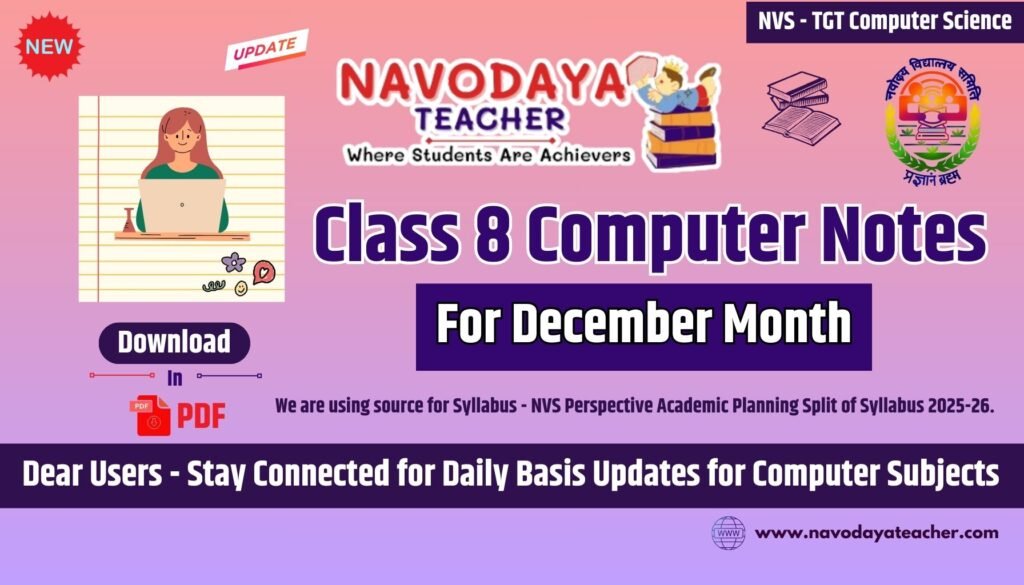In this article we provide information regarding latest Navodaya Class 8 Computer Notes – December Month TGT Computer Science (CS) 2025-26.
Navodaya Class 8 Computer Notes – December Month
We are using source for Syllabus – Navodaya Vidyalaya Samiti Perspective Academic Planning Split of Syllabus 2025-26.
We are giving to the Point Notes for the Students.
Thanks Me Later
For the December Month Notes – Class 8 Computer Subject
Unites we covered in Notes
Introduction to Problem Solving Programming Contin…
✓ Understanding and preparing Flowcharts
✓ Evolution of programming language
✓ Types of programming language
Understanding and Preparing Flowcharts
Flowchart:
- A flowchart is a diagram that shows the steps of a process using symbols and arrows.
- It helps to plan a program before writing code.
Common Symbols in Flowcharts:
- Oval (Ellipse): Start / End
- Parallelogram: Input / Output (data in, result out)
- Rectangle: Process (calculation or action)
- Diamond: Decision (Yes/No, True/False)
- Arrow: Flow of direction
Example: Flowchart to add two numbers
- Start (Oval)
- Input two numbers (Parallelogram)
- Add numbers (Rectangle)
- Display result (Parallelogram)
- End (Oval)
Evolution of Programming Language
Programming languages have developed in different generations:
- Machine Language (1st Generation)
- Written in 0s and 1s (binary).
- Very difficult to understand.
- Example:
10110011.
- Assembly Language (2nd Generation)
- Uses short words called mnemonics (ADD, SUB, MOV).
- Easier than machine language.
- Needs assembler to convert into machine code.
- High-Level Languages (3rd Generation)
- Written in English-like statements.
- Easy to learn and understand.
- Needs compiler/interpreter to convert into machine code.
- Examples: C, BASIC, FORTRAN, Pascal.
- Very High-Level Languages (4th Generation)
- Focuses on what to do rather than how to do it.
- Used in database and application development.
- Examples: SQL, MATLAB.
- 5th Generation Languages
- Based on Artificial Intelligence (AI) and logic.
- Examples: Prolog, Mercury.
Types of Programming Language
- Machine Language
- Binary (0s and 1s).
- Very fast but hard to write.
- Assembly Language
- Uses mnemonics.
- Easier than binary.
- High-Level Language
- English-like words.
- Portable and widely used.
- Examples: C, C++, Java, Python.
- Object-Oriented Language
- Based on objects and classes.
- Encourages reusability and modular coding.
- Examples: Java, C++, Python.
Key Points to Remember – Problem Solving Programming
- Flowchart = diagram with symbols showing step-by-step solution.
- Programming languages evolved from binary → mnemonics → English-like → AI-based.
- Types: Machine, Assembly, High-level, Object-oriented.
Thanks to Beloved Readers.













